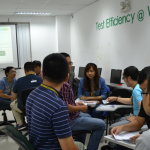
Most software engineers intuitively perform BVA to some degree. By applying these guidelines, boundary testing will be more complete, thereby having a higher likelihood for error detection.
Software is tested from two different perspectives:
1. Internal program logic is exercised using “white box” test case design techniques.
2. Software requirements are exercised using “black box” test case design techniques.
In both cases, the intent is to find the maximum number of errors with the minimum amount of effort and time.
Black-box testing alludes to tests that are conducted at the software interface. Although they are designed to uncover errors, black-box tests are used to demonstrate that software functions are operational, that input is properly accepted and output is correctly produced, and that the integrity of external information (e.g., a database) is maintained. A black-box test examines some fundamental aspects of a system with little regard for the internal logical structure of the software.
Black Box Testing Techniques
Black-box testing, also called behavioral testing, focuses on the functional requirements of the software. That is, black-box testing enables the software engineer to derive sets of input conditions that will fully exercise all functional requirements for a program. Black-box testing is not an alternative to white-box techniques. Rather, it is a complementary approach that is likely to uncover a different class of errors than white-box methods.
Black-box testing attempts to find errors in the following categories:
1. Incorrect or missing functions.
2. Interface errors.
3. Errors in data structures or external database access.
4. Behavior or performance errors, and
5. Initialization and termination errors.
Unlike white-box testing, which is performed early in the testing process, black box testing tends to be applied during later stages of testing.
Because black-box testing purposely disregards control structure, attention is focused on the information domain. Tests are designed to answer the following questions:
- How is functional validity tested?
- How is system behavior and performance tested?
- What classes of input will make good test cases?
- Is the system particularly sensitive to certain input values?
- How are the boundaries of a data class isolated?
- What data rates and data volume can the system tolerate?
- What effect will specific combinations of data have on system operation?
- There are various techniques in developing test cases for black box testing. I will be explaining two of the most common techniques, Equivalence Partitioning and BVA (Boundary Value Analysis)
Equivalence Partitioning
Equivalence partitioning is a black-box testing method that divides the input domain of a program into classes of data from which test cases can be derived. Test case design for equivalence partitioning is based on an evaluation of equivalence classes for an input condition. An equivalence class represents a set of valid or invalid states for input conditions. Typically, an input condition is either a specific numeric value, a range of values, a set of related values, or a boolean condition. Equivalence classes may be defined according to the following guidelines:
1. If an input condition specifies a range, one valid and two invalid equivalence classes are defined.
2. If an input condition requires a specific value, one valid and two invalid equivalence classes are defined.
3. If an input condition specifies a member of a set, one valid and one invalid equivalence class are defined.
4. If an input condition is boolean, one valid and one invalid class are defined.
As an example, consider data maintained as part of an automated banking application.
The user can access the bank using a personal computer, provide a six-digit password, and follow with a series of typed commands that trigger various banking functions. During the log-on sequence, the software supplied for the banking application accepts data in the form:
- Area code—blank or three-digit number.
- Prefix—three-digit number not beginning with 0 or 1
- Suffix—four-digit number.
- Password—six digit alphanumeric string.
- Commands—check, deposit, bill pay, and the like.
The input conditions associated with each data element for the banking application can be specified as area code:
- Input condition, Boolean—the area code may or may not be present.
- Input condition, range—values defined between 200 and 999, with specific exceptions.
- Prefix: Input condition, range—specified value >200.
- Input condition, value—four-digit length.
- Password: Input condition, Boolean—a password may or may not be present.
- Input condition, value—six-character string.
- Command: Input condition, set—containing commands noted previously.
Applying the guidelines for the derivation of equivalence classes, test cases for each input domain data item can be developed and executed. Test cases are selected so that the largest number of attributes of an equivalence class are exercised at once.
Boundary Value Analysis
BVA extends equivalence partitioning by focusing on data at the “edges” of an equivalence class.
For reasons that are not completely clear, a greater number of errors tends to occur at the boundaries of the input domain rather than in the “center”. It is for this reason that boundary value analysis (BVA) has been developed as a testing technique. Boundary value analysis leads to a selection of test cases that exercise bounding values.
Boundary value analysis is a test case design technique that complements equivalence partitioning. Rather than selecting any element of an equivalence class, BVA leads to the selection of test cases at the “edges” of the class. Rather than focusing solely on input conditions, BVA derives test cases from the output domain as well.
Guidelines for BVA are similar in many respects to those provided for equivalence partitioning:
- If an input condition specifies a range bounded by values a and b, test cases should be designed with values a and b and values just above and just below a and b.
- If an input condition specifies a number of values, test cases should be developed that exercise the minimum and maximum numbers. Values just above and below minimum and maximum are also tested.
- Apply guidelines 1 and 2 to output conditions. For example, assume that a temperature vs. pressure table is required as output from an engineering analysis program. Test cases should be designed to create an output report that produces the maximum (and minimum) allowable number of table entries.
- If internal program data structures have prescribed boundaries (e.g., an array has a defined limit of 100 entries), be certain to design a test case to exercise the data structure at its boundary.
Most software engineers intuitively perform BVA to some degree. By applying these guidelines, boundary testing will be more complete, thereby having a higher likelihood for error detection.
| Robin Roy, PMP Robin works as a Senior Consultant with Brilliance MSC, Malaysia. He loves to evaluate new technologies and implement the same. Believes in sharing knowledge. |
















